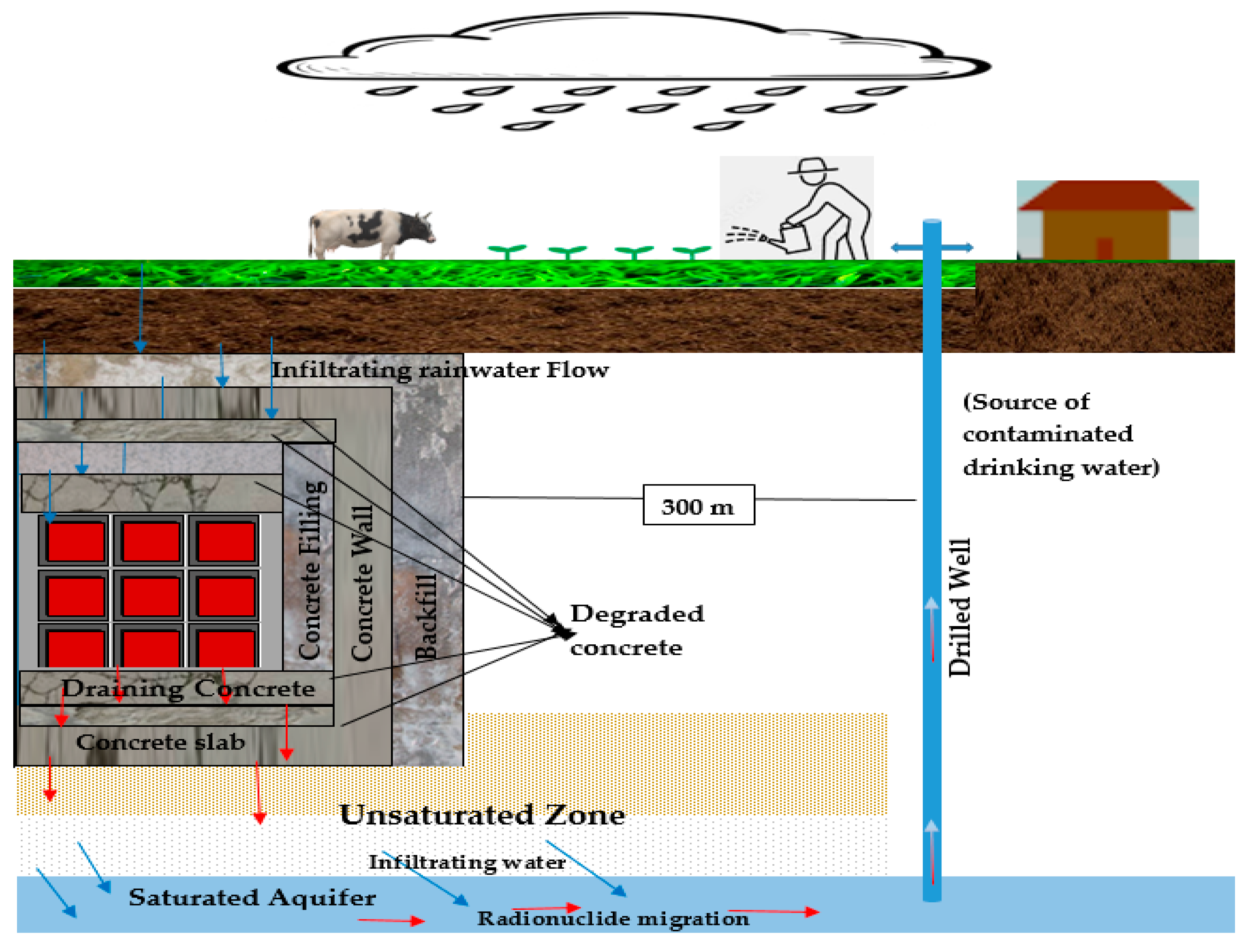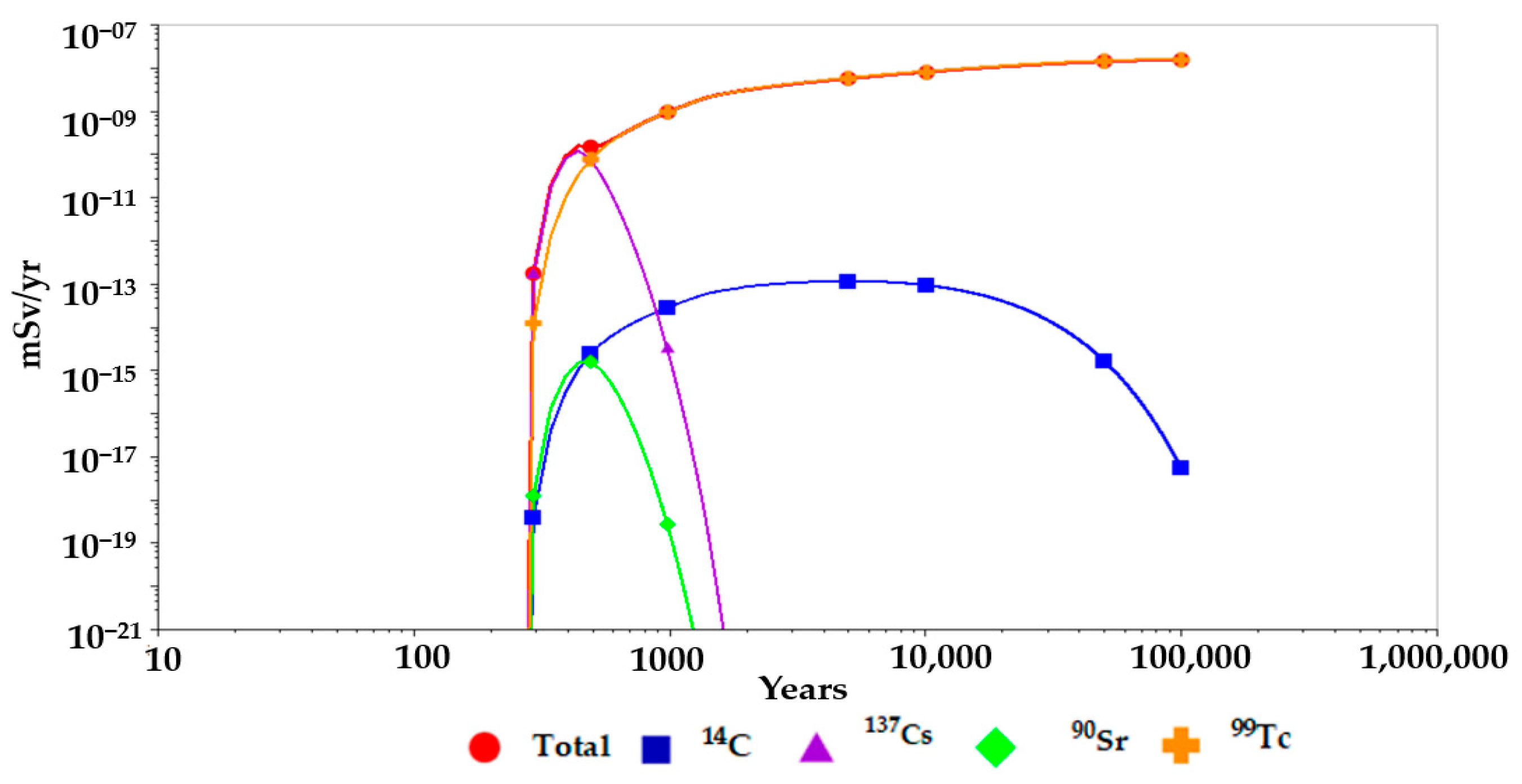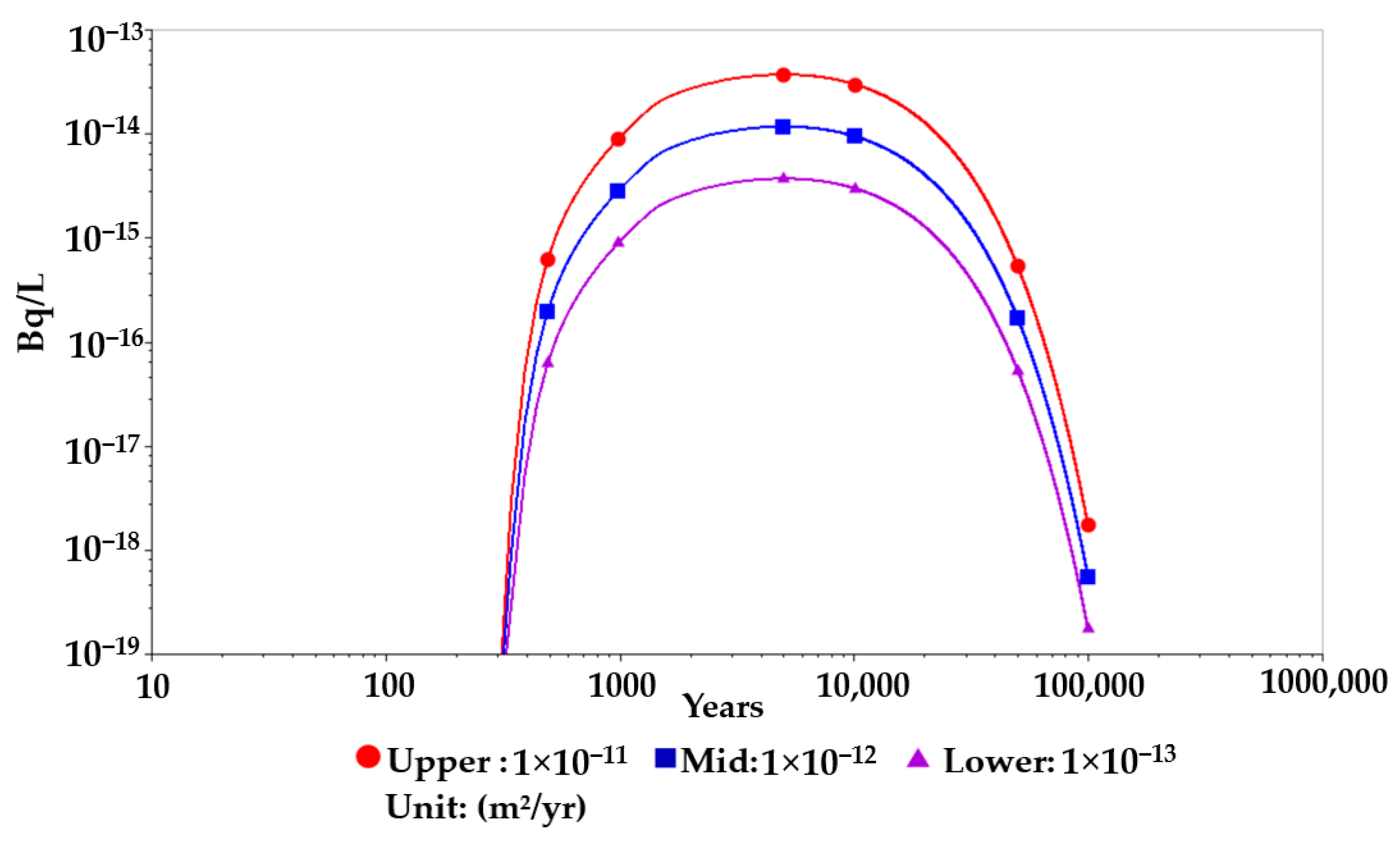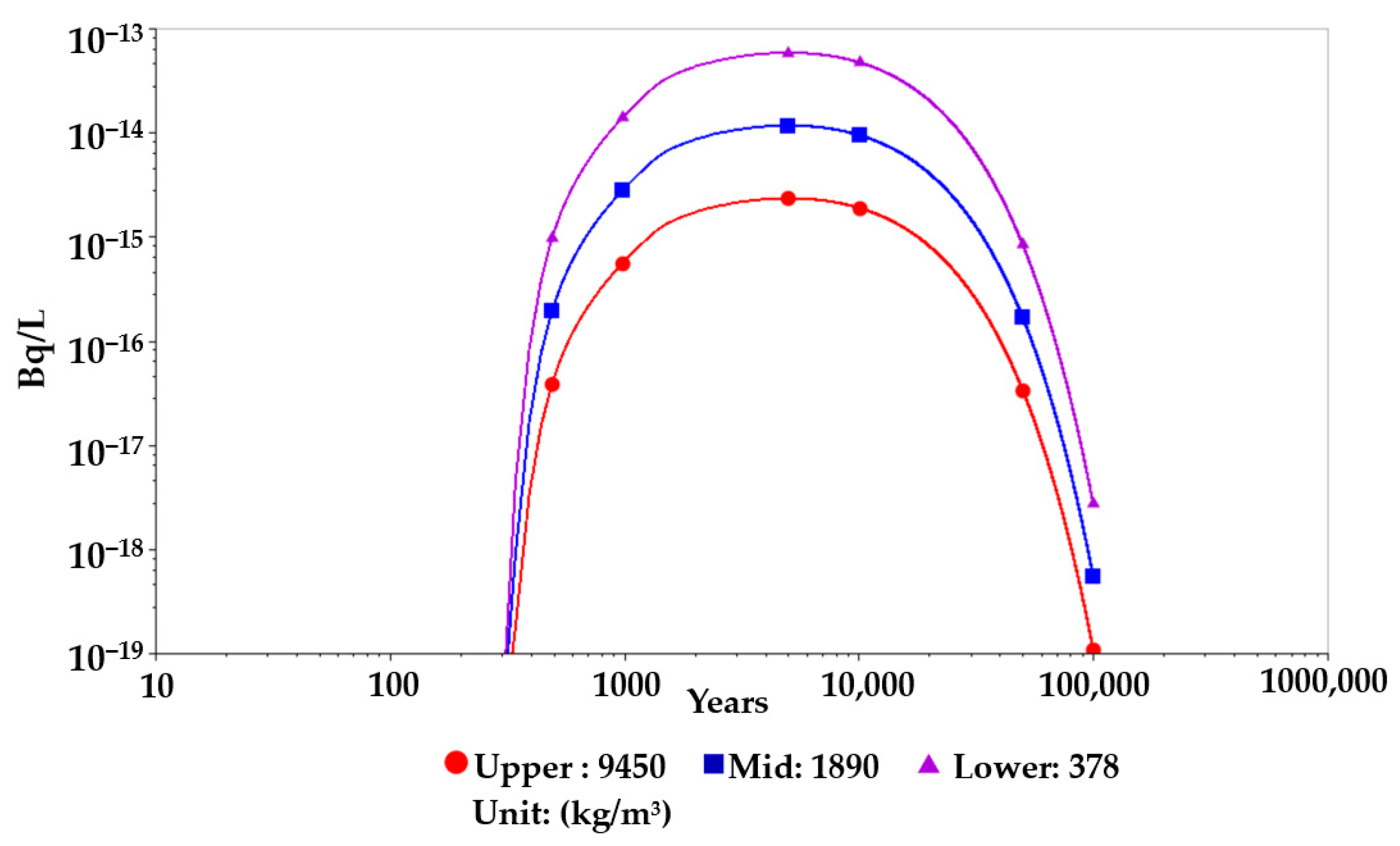Impact of Concrete Degradation on the Long-Term Safety of a Near-Surface Radioactive Waste Disposal Facility in Korea
Abstract
:1. Introduction
2. Materials and Methods
2.1. Geochemical Degradation of Concrete
2.2. RESRAD-OFFSITE Modeling Overview
2.3. Radionuclide Release Modeling
3. Results
4. Discussion
5. Conclusions
Author Contributions
Funding
Institutional Review Board Statement
Informed Consent Statement
Data Availability Statement
Conflicts of Interest
References
- Crossland, I. Disposal of radioactive waste. In Nuclear Fuel Cycle Science and Engineering; Woodhead Publishing: Cambridge, UK, 2012; pp. 531–557. [Google Scholar] [CrossRef]
- IAEA. Safety Standards for Protecting People and the Environment Specific Safety Guide No. SSG-29 Near Surface Disposal Facilities for Radioactive Waste. Available online: http://www-ns.iaea.org/standards/ (accessed on 13 May 2022).
- Park, S.J.; Shin, B.S.; Ahn, S.; Lee, J.Y. Safety assessment of second-phase disposal facility in Gyeongju low- and intermediate-level radioactive waste (LILW) repository using RESRAD-OFFSITE code. J. Nucl. Sci. Technol. 2021, 58, 1256–1265. [Google Scholar] [CrossRef]
- Shin, Y.-L.; Kim, Y.-H. The Status of LILW Complex Disposal Facility Construction in Korea-17123. 2017. Available online: https://inis.iaea.org/search/search.aspx?orig_q=RN%3A50038747 (accessed on 13 May 2022).
- International Atomic Energy Agency. Technical Considerations in the Design of Near Surface Disposal Facilities for Radioactive Waste; International Atomic Energy Agency: Vienna, Austria, 2001; pp. 6–9. [Google Scholar]
- Kim, Y.-K. The Korean Final Repository for Low and Intermediate Level Radioactive Waste. Presented at the 11th International Conference on Environmental Remediation and Radioactive Waste Management, Brugge, Belgium, 2–6 September 2007; The American Society of Mechanical Engineers: New York, NY, USA, 2019; Available online: https://searchworks.stanford.edu/view/8252953 (accessed on 18 May 2022).
- Glasser, F.P.; Atkins, M. Cements in Radioactive Waste Disposal. Mrs Bull. 1994, 19, 33–38. [Google Scholar] [CrossRef]
- Drace, Z.; Ojovan, M.I. The behaviours of cementitious materials in long term storage and disposal: An overview of results of the IAEA Coordinated Research Project. MRS Online Proc. Libr. (OPL) 2009, 1193, 663. [Google Scholar] [CrossRef]
- Koťátková, J.; Zatloukal, J.; Reiterman, P.; Kolář, K. Concrete and cement composites used for radioactive waste deposition. J. Environ. Radioact. 2017, 178–179, 147–155. [Google Scholar] [CrossRef] [PubMed]
- Mallants, D.; Ochs, M.; Wang, L.; Land, C.; Road, W.; Sa, G.O. A new radionuclide sorption database for cementitious materials accounting for geochemical evolution. In Proceedings of the Waste Management 2018 Conference, Phoenix, AZ, USA, 18–22 March 2018; Available online: https://www.researchgate.net/publication/321860575 (accessed on 12 May 2022).
- Perko, J.; Mallants, D.; Jacques, D.; Wang, L. Coupling Time-Dependent Sorption Values of Degrading Concrete with a Radionuclide Migration Model. In Proceedings of the ASME 2009 12th International Conference on Radioactive Waste Management and Environmental Remediation, Liverpool, UK, 11–15 October 2009; Volume 1, pp. 9–17. [Google Scholar]
- Ochs, M.; Mallants, D.; Wang, L. Radionuclide and Metal Sorption on Cement and Concrete; Topics in Safety, Risk, Reliability and Quality; Springer: Berlin/Heidelberg, Germany, 2016. [Google Scholar] [CrossRef]
- Chen, Q.Y.; Tyrer, M.; Hills, C.D.; Yang, X.M.; Carey, P. Immobilisation of heavy metal in cement-based solidification/stabilisation: A review. Waste Manag. 2009, 29, 390–403. [Google Scholar] [CrossRef] [PubMed]
- Han, S.C.; Jo, Y.; Yun, J.I. Chemical degradation of fly ash blended concrete with the seasonal variation of rainwater in a radioactive waste repository: A thermodynamic modeling approach. Cem. Concr. Res. 2021, 141, 106326. [Google Scholar] [CrossRef]
- Glasser, F.P.; Marchand, J.; Samson, E. Durability of concrete—Degradation phenomena involving detrimental chemical reactions. Cem. Concr. Res. 2008, 38, 226–246. [Google Scholar] [CrossRef]
- Wang, L.; Cen, S.C.K.; Martens, E.; Cen, S.C.K.; Jacques, D.; Cen, S.C.K. 18-Review of Sorption Values for the Cementitious near Field of a Near-Surface Radioactive Waste Disposal. Presented at Conference: Cementitious Materials in Safety Cases for Geological Repositories for Radioactive Waste: Role, Evolution and Interaction, OECD/NEA/RWM/R(2012). Volume 3, pp. 225–230. Available online: https://www.researchgate.net/publication/243055828 (accessed on 6 June 2022).
- Jung, J.; Lee, J.K.; Hahn, P.S. Development and application of a sorption data base for the performance assessment of a radwaste repository. Waste Manag. 2001, 21, 363–369. [Google Scholar] [CrossRef]
- Kanellopoulos, A. Concrete Deterioration: Physical and Chemical Mechanisms. In Handbook of Concrete Durability; Middleton Publishing Inc.: Haslemere, UK, 2010; pp. 1–32. Available online: https://www.researchgate.net/publication/267390352 (accessed on 19 May 2022).
- Yu, C.; Gnanapragasam, E.; Cheng, J.J.; LePoire, D.; Kamboj, S.; Wang, C. User ’s Manual for Resrad-Offsite Code Version 4 (NUREG/CR-7268); Argonne National Laboratory Lemont: Lemont, IL, USA, 2020; Volume 1, pp. 1–544. [Google Scholar]
- Sullivan, T.; Report, I. Recommended Values for the Distribution Coefficient (Kd) to Be Used in Dose Assessments for Decommissioning; USDOE Office of Science: Washington, DC, USA, 2014. [Google Scholar]







| Radionuclide | Half-Life (Years) | Distribution Coefficient (cm3/g) | Diffusion Coefficient (m2/yr) | |
|---|---|---|---|---|
| State II | State IV | |||
| 14C | 5700 | 5000 | 100 | 1 × 10−12 |
| 90Sr | 28.8 | 30 | 1 | 5 × 10−11 |
| 99Tc | 211,000 | 3000 | 1 | 1 × 10−8 |
| 137Cs | 30 | 20 | 0 | 5 × 10−10 |
| RESRAD Parameters | Value |
|---|---|
| Cover thickness | 5.8 m |
| Area of contaminated zone | 16,400 m2 |
| Thickness of contaminated zone | 6.2 m |
| Density of contaminated zone | 1890 kg/m3 |
| Total volume of waste | 33,600 m3 |
| Total Porosity of contaminated zone | 0.00001 |
| Hydraulic conductivity of contaminated zone | 30 m/yr |
| Unsaturated zone thickness | 79.3 m |
| Unsaturated zone density | 1770 kg/m3 |
| Hydraulic conductivity of unsaturated zone | 12.54 m/yr |
| Saturated zone thickness | 100 m ** |
| Saturated zone density | 3060 kg/m3 |
| Drinking water intake | 730 L/yr ** |
| Well pumping rate | 50,000 m3/yr |
| Inhalation rate | 7400 m3/yr |
| Wind speed | 2.45 m/s |
| Precipitation | 1.3 m/yr |
| Distance parallel to aquifer (Well) | 300 m |
| Distance parallel to aquifer (Surface water) | 450 m |
| Year | 14C | 137Cs | 90Sr | 99Tc | ||||
|---|---|---|---|---|---|---|---|---|
| Kd = 5000 | Kd = 100 | Kd = 20 | Kd = 0 | Kd = 30 | Kd = 1 | Kd = 3000 | Kd = 1 | |
| 300 | 1.2 × 10−21 | 3.9 × 10−19 | 8.4 × 10−20 | 1.7 × 10−13 | 3.0 × 10−20 | 1.3 × 10−18 | 4.0 × 10−19 | 1.2 × 10−14 |
| 500 | 7.6 × 10−18 | 2.4 × 10−15 | 1.1 × 10−16 | 7.9 × 10−11 | 3.7 × 10−17 | 1.6 × 10−15 | 2.5 × 10−15 | 7.7 × 10−11 |
| 1000 | 1.0 × 10−16 | 3.2 × 10−14 | 1.1 × 10−20 | 1.1 × 10−15 | 2.2 × 10−21 | 9.4 × 10−20 | 3.5 × 10−14 | 1.1 × 10−9 |
| 5000 | 3.6 × 10−16 | 1.1 × 10−13 | 0 | 0 | 0 | 0 | 2.0 × 10−13 | 5.8 × 10−9 |
| 10,000 | 2.9 × 10−16 | 9.2 × 10−14 | 0 | 0 | 0 | 0 | 2.9 × 10−13 | 8.2 × 10−9 |
| 50,000 | 5.2 × 10−18 | 1.6 × 10−15 | 0 | 0 | 0 | 0 | 5.8 × 10−13 | 1.4 × 10−8 |
| 100,000 | 1.7 × 10−20 | 5.3 × 10−18 | 0 | 0 | 0 | 0 | 6.9 × 10−13 | 1.5 × 10−8 |
| Year | 14C | 137Cs | 90Sr | 99Tc | ||||
|---|---|---|---|---|---|---|---|---|
| Upper: 10,000 | Lower: 2500 | Upper: 200 | Lower: 2 | Upper: 300 | Lower: 3 | Upper: 30,000 | Lower: 300 | |
| 300 | 2.9 × 10−17 | 5.8 × 10−17 | 6.1 × 10−17 | 1.7 × 10−16 | 6.8 × 10−18 | 2.2 × 10−17 | 3.0 × 10−15 | 2.8 × 10−14 |
| 500 | 1.8 × 10−15 | 3.7 × 10−15 | 8.2 × 10−16 | 2.3 × 10−15 | 8.5 × 10−17 | 2.8 × 10−16 | 1.9 × 10−13 | 1.8 × 10−12 |
| 1000 | 2.5 × 10−14 | 4.9 × 10−14 | 8.6 × 10−20 | 2.4 × 10−19 | 5.1 × 10−21 | 1.7 × 10−20 | 2.7 × 10−12 | 2.6 × 10−11 |
| 5000 | 8.8 × 10−14 | 1.8 × 10−13 | 0 | 0 | 0 | 0 | 1.5 × 10−11 | 1.4 × 10−10 |
| 10,000 | 7.1 × 10−14 | 1.4 × 10−13 | 0 | 0 | 0 | 0 | 2.2 × 10−11 | 2.1 × 10−10 |
| 50,000 | 1.3 × 10−15 | 2.5 × 10−15 | 0 | 0 | 0 | 0 | 4.5 × 10−11 | 4.1 × 10−10 |
| 100,000 | 4.1 × 10−18 | 8.2 × 10−18 | 0 | 0 | 0 | 0 | 5.4 × 10−11 | 4.8 × 10−10 |
| Year | 14C | 137Cs | 90Sr | 99Tc | ||||
|---|---|---|---|---|---|---|---|---|
| Upper: 1 × 10−11 | Lower: 1 × 10−13 | Upper: 5 × 10−09 | Lower: 5 × 10−11 | Upper: 5 × 10−10 | Lower: 5 × 10−12 | Upper: 1 × 10−7 | Lower: 1 × 10−9 | |
| 300 | 1.3 × 10−16 | 1.3 × 10−17 | 4.3 × 10−16 | 4.3 × 10−17 | 5.1 × 10−17 | 5.1 × 10−18 | 3.0 × 10−14 | 3.0 × 10−15 |
| 500 | 8.2 × 10−15 | 8.2 × 10−16 | 5.7 × 10−15 | 5.7 × 10−16 | 6.5 × 10−16 | 6.5 × 10−17 | 1.9 × 10−12 | 1.9 × 10−13 |
| 1000 | 1.1 × 10−13 | 1.1 × 10−14 | 5.9 × 10−19 | 6.0 × 10−20 | 3.8 × 10−20 | 3.8 × 10−21 | 2.7 × 10−11 | 2.7 × 10−12 |
| 5000 | 3.9 × 10−13 | 3.9 × 10−14 | 0 | 0 | 0 | 0 | 1.5 × 10−10 | 1.5 × 10−11 |
| 10,000 | 3.2 × 10−13 | 3.2 × 10−14 | 0 | 0 | 0 | 0 | 2.2 × 10−10 | 2.2 × 10−11 |
| 50,000 | 5.7 × 10−15 | 5.7 × 10−16 | 0 | 0 | 0 | 0 | 4.2 × 10−10 | 4.5 × 10−11 |
| 100,000 | 1.8 × 10−17 | 1.8 × 10−18 | 0 | 0 | 0 | 0 | 4.9 × 10−10 | 5.4 × 10−11 |
Publisher’s Note: MDPI stays neutral with regard to jurisdictional claims in published maps and institutional affiliations. |
© 2022 by the authors. Licensee MDPI, Basel, Switzerland. This article is an open access article distributed under the terms and conditions of the Creative Commons Attribution (CC BY) license (https://creativecommons.org/licenses/by/4.0/).
Share and Cite
Mutoni, A.; Kim, J. Impact of Concrete Degradation on the Long-Term Safety of a Near-Surface Radioactive Waste Disposal Facility in Korea. Appl. Sci. 2022, 12, 9009. https://doi.org/10.3390/app12189009
Mutoni A, Kim J. Impact of Concrete Degradation on the Long-Term Safety of a Near-Surface Radioactive Waste Disposal Facility in Korea. Applied Sciences. 2022; 12(18):9009. https://doi.org/10.3390/app12189009
Chicago/Turabian StyleMutoni, Agnes, and Juyoul Kim. 2022. "Impact of Concrete Degradation on the Long-Term Safety of a Near-Surface Radioactive Waste Disposal Facility in Korea" Applied Sciences 12, no. 18: 9009. https://doi.org/10.3390/app12189009






